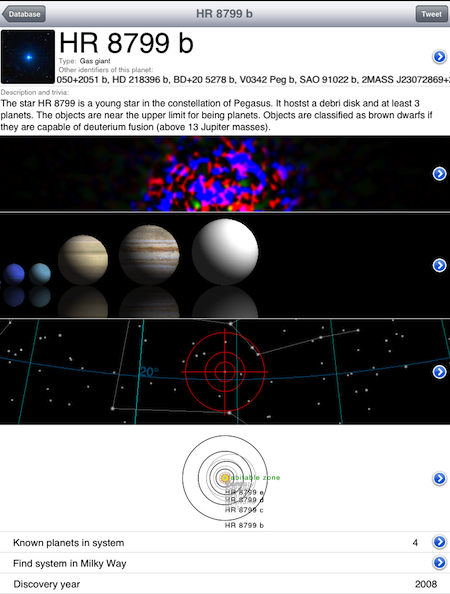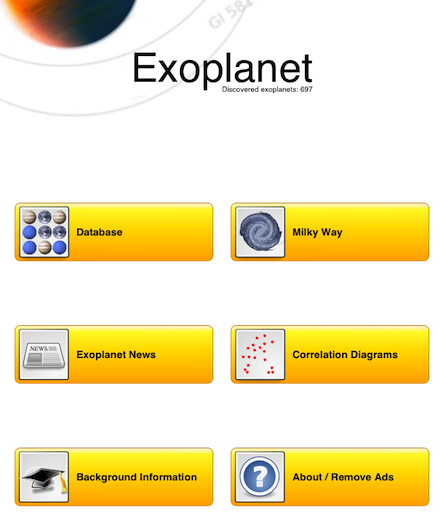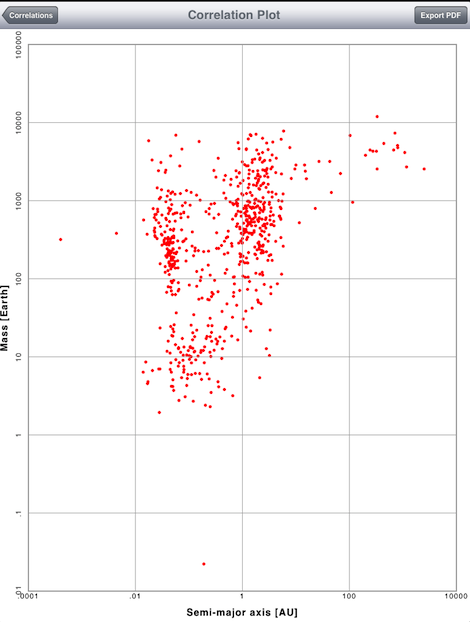ExoplanetÂ
App Developer: Hanno Rein
Version Reviewed: 5.6
License: Free (US $0.99 without ads). Universal app compatible with all iOS 3.1.3 or later devices.
As a member of the front end of the “baby boomers” I can still remember learning that our sun was just an average star and we were one of nine planets orbiting it. I also learned that our Milky Way was one of several hundred billion galaxies that made up our known universe, each containing hundreds of billions of stars. That begged the question: if our star had planets then should the rest of the stars have planets too? It seemed like the obvious answer was yes, but until the end of the twentieth century, the question remained unanswered. Due to the advancement of technology, astronomers have confirmed the existence of nearly 700 planets orbiting around nearby stars in our own galaxy and have currently identified over 600 additional possible planets; and the number continues to grow.
Today, as an amateur astronomer, I enjoy sharing the the night sky with the public as part of my volunteer community outreach activities. Planets orbiting our sun are relatively easy to see in most amateur telescopes with the exception of the newly defined dwarf planets. Planets orbiting neighboring stars, exoplanets, (http://en.wikipedia.org/wiki/Extrasolar_planet) are still left to the professional astronomers.
The Exoplanet iOS App brings these newly identified solar systems to life for all of us to easily enjoy without having to look through a telescope. The application is a database containing all of the confirmed exoplanets and their known characteristics. Access to this information is provided through a simple menu that includes the database, news about exoplanets, background information, a dynamic animation of the exoplanets in our galaxy, and an interactive mathematical correlation routine. The Database menu lists the name of the exoplanet, its mass, orbital period, eccentricity, year when discovered, and the method used to detect it. This data is updated as new information is made public.
Selecting any of these exoplanets within the database, such as HR 8799 b as an example, brings up another layer of details, including beautiful animations and illustrations of where the exoplanet is located, how it compares to the size of planets in our own solar system, where it resides in our night sky, and how it would overlay in our solar system. One can apply filters to selectively sort through the database to further refine details the user may be interested in. One can really have a lot of fun and easily spend an enormous amount of time just playing around with the database.
If you want to learn more about what is going on in the search and discovery of exoplanets, just visit the Exoplanet News menu. There you will find current information about ongoing research including many links to the latest scientific papers, articles, and press releases. There are even links that seamlessly take you back into the application’s main database.
If you are not very familiar with the science of exoplanets and how they are detected, just visit the Background Information menu. There you can learn about the various methods astronomers use to detect and observe exoplanets. Nicely illustrated with simple mathematical formulas and easily understood explanations provide even the novice with a comfortable understanding of general subject covering the search and detection of exoplanets. Like the News menu, links within this menu can take you back into the main database.
The third menu, titled Milky Way, allows one to manipulate and view a three dimensional model of our galaxy and select an exoplanet to zoom in and observe it orbiting its parent star. As you zoom in you are provided with a scale that starts in light years and ends up in astronomical units showing the distance the selected exoplanet is orbiting its parent star. To search and zoom in on a specific exoplanet, one just has to touch the search button (magnifying glass) and select the desired exoplanet from the main database. Simply touching the little concentric circles button in the upper left cover of the display returns you to our own solar system. Double tap the display and you zoom back to the outside of our galaxy. The information button on this display provides you with additional details on how to use this visualization display.
The Correlation Diagrams menu provides one with the ability to plot mathematical correlation diagrams for a multitude of exoplanet characteristics. These include semi-major axis, eccentricity, mass (Earth or Jupiter), orbital period, host star metallicity (http://en.wikipedia.org/wiki/Metallicity), year discovered, planet radius (Earth or Jupiter), distance and inclination. Plot axis can be logarithmic or non logarithmic on the x or y or both. Correlation plots are nicely displayed and provide a good deal of information but may not be of great interest to the novice. For an example, one can plot the distribution of all the known exoplanets relative to the earth’s mass versus the semi major axis radius in astronomical units.
Last, the About menu provides additional information about the application and the many individuals who helped with the development, plus links to the sources of the database and how to contact the developer. If you are using the free version of the application, this sections provides the button to upgrade to the US $0.99 ad free version. Hanno Rein did a great job developing this application. For this price, I encourage anyone with an interest in astronomy to buy it. Again, this is a well behaved application running on my first version iPad that I thoroughly enjoy using with my astronomy outreach activities. Therefore I am awarding this app a MyMac review rating of 10 out of 10.





Leave a Reply
You must be logged in to post a comment.